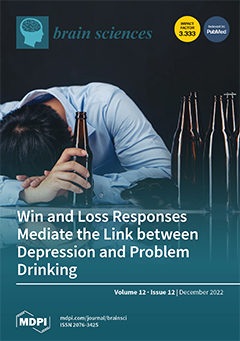Open AccessArticle
Individual- and Connectivity-Based Real-Time fMRI Neurofeedback to Modulate Emotion-Related Brain Responses in Patients with Depression: A Pilot Study
by
Maximilian Maywald, Marco Paolini, Boris Stephan Rauchmann, Christian Gerz, Jan Lars Heppe, Annika Wolf, Linda Lerchenberger, Igor Tominschek, Sophia Stöcklein, Paul Reidler, Nadja Tschentscher, Birgit Ertl-Wagner, Oliver Pogarell, Daniel Keeser and Susanne Karch
Cited by 2 | Viewed by 2184
Abstract
Introduction: Individual real-time functional magnetic resonance imaging neurofeedback (rtfMRI NF) might be a promising adjuvant in treating depressive symptoms. Further studies showed functional variations and connectivity-related changes in the dorsolateral prefrontal cortex (dlPFC) and the insular cortex. Objectives: The aim of this pilot
[...] Read more.
Introduction: Individual real-time functional magnetic resonance imaging neurofeedback (rtfMRI NF) might be a promising adjuvant in treating depressive symptoms. Further studies showed functional variations and connectivity-related changes in the dorsolateral prefrontal cortex (dlPFC) and the insular cortex. Objectives: The aim of this pilot study was to investigate whether individualized connectivity-based rtfMRI NF training can improve symptoms in depressed patients as an adjunct to a psychotherapeutic programme. The novel strategy chosen for this was to increase connectivity between individualized regions of interest, namely the insula and the dlPFC. Methods: Sixteen patients diagnosed with major depressive disorder (MDD, ICD-10) and 19 matched healthy controls (HC) participated in a rtfMRI NF training consisting of two sessions with three runs each, within an interval of one week. RtfMRI NF was applied during a sequence of negative emotional pictures to modulate the connectivity between the dlPFC and the insula. The MDD REAL group was divided into a Responder and a Non-Responder group. Patients with an increased connectivity during the second NF session or during both the first and the second NF session were identified as “MDD REAL Responder” (N = 6). Patients that did not show any increase in connectivity and/or a decreased connectivity were identified as “MDD REAL Non-Responder” (N = 7). Results: Before the rtfMRI sessions, patients with MDD showed higher neural activation levels in ventromedial PFC and the insula than HC; by contrast, HC revealed increased hemodynamic activity in visual processing areas (primary visual cortex and visual association cortex) compared to patients with MDD. The comparison of hemodynamic responses during the first compared to during the last NF session demonstrated significantly increased BOLD-activation in the medial orbitofrontal cortex (mOFC) in patients and HC, and additionally in the lateral OFC in patients with MDD. These findings were particularly due to the MDD Responder group, as the MDD Non-Responder group showed no increase in this region during the last NF run. There was a decrease of neural activation in emotional processing brain regions in both groups in the last NF run compared to the first: HC showed differences in the insula, parahippocampal gyrus, basal ganglia, and cingulate gyrus. Patients with MDD demonstrated deceased responses in the parahippocampal gyrus. There was no significant reduction of BDI scores after NF training in patients. Conclusions: Increased neural activation in the insula and vmPFC in MDD suggests an increased emotional reaction in patients with MDD. The activation of the mOFC could be associated with improved control-strategies and association-learning processes. The increased lOFC activation could indicate a stronger sensitivity to failed NF attempts in MDD. A stronger involvement of visual processing areas in HC may indicate better adaptation to negative emotional stimuli after repeated presentation. Overall, the rtfMRI NF had an impact on neurobiological mechanisms, but not on psychometric measures in patients with MDD.
Full article
►▼
Show Figures






